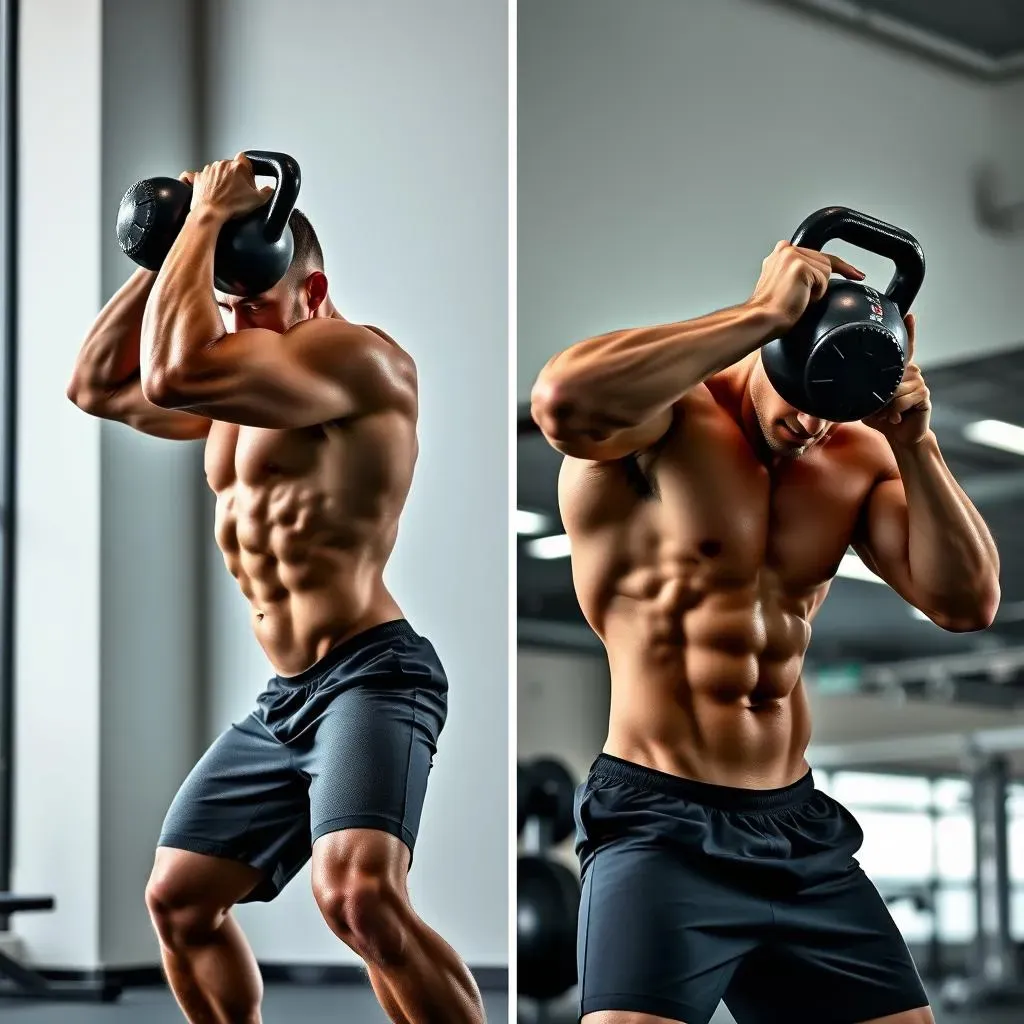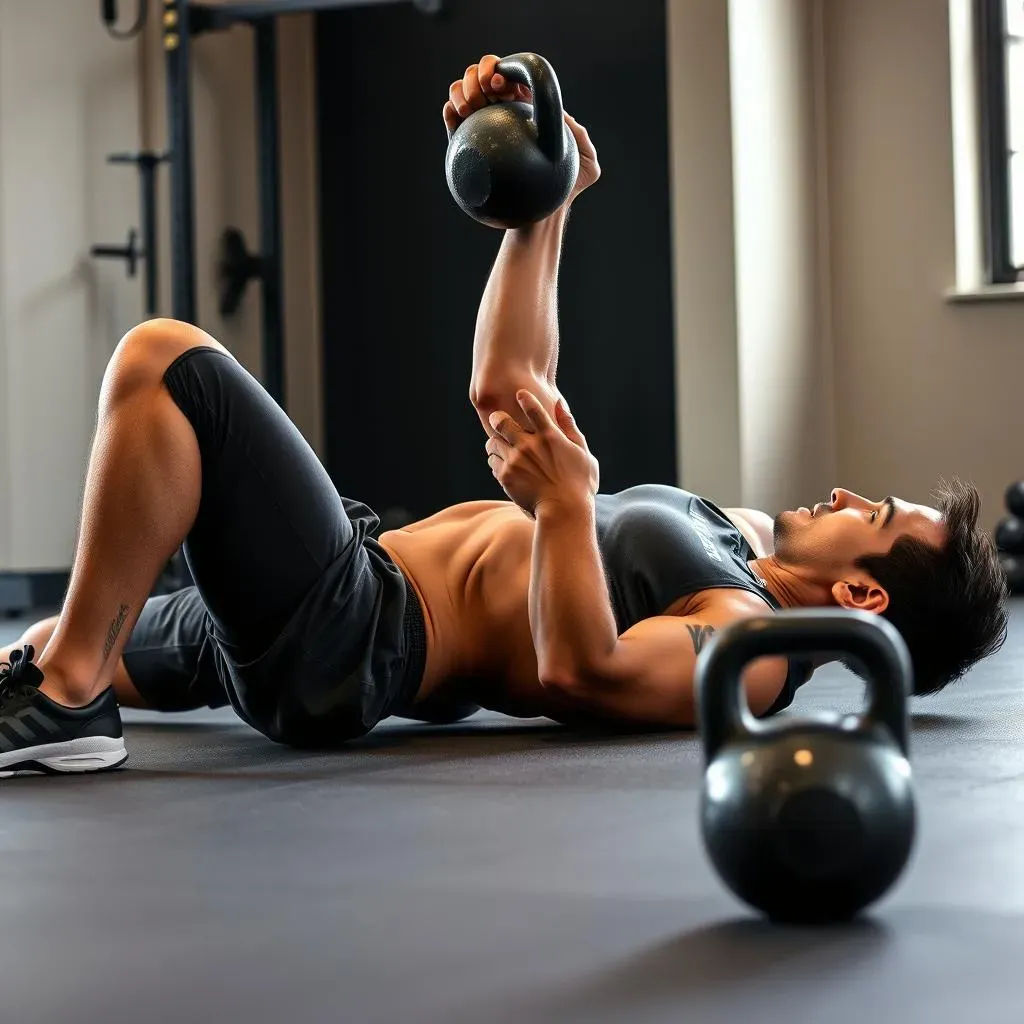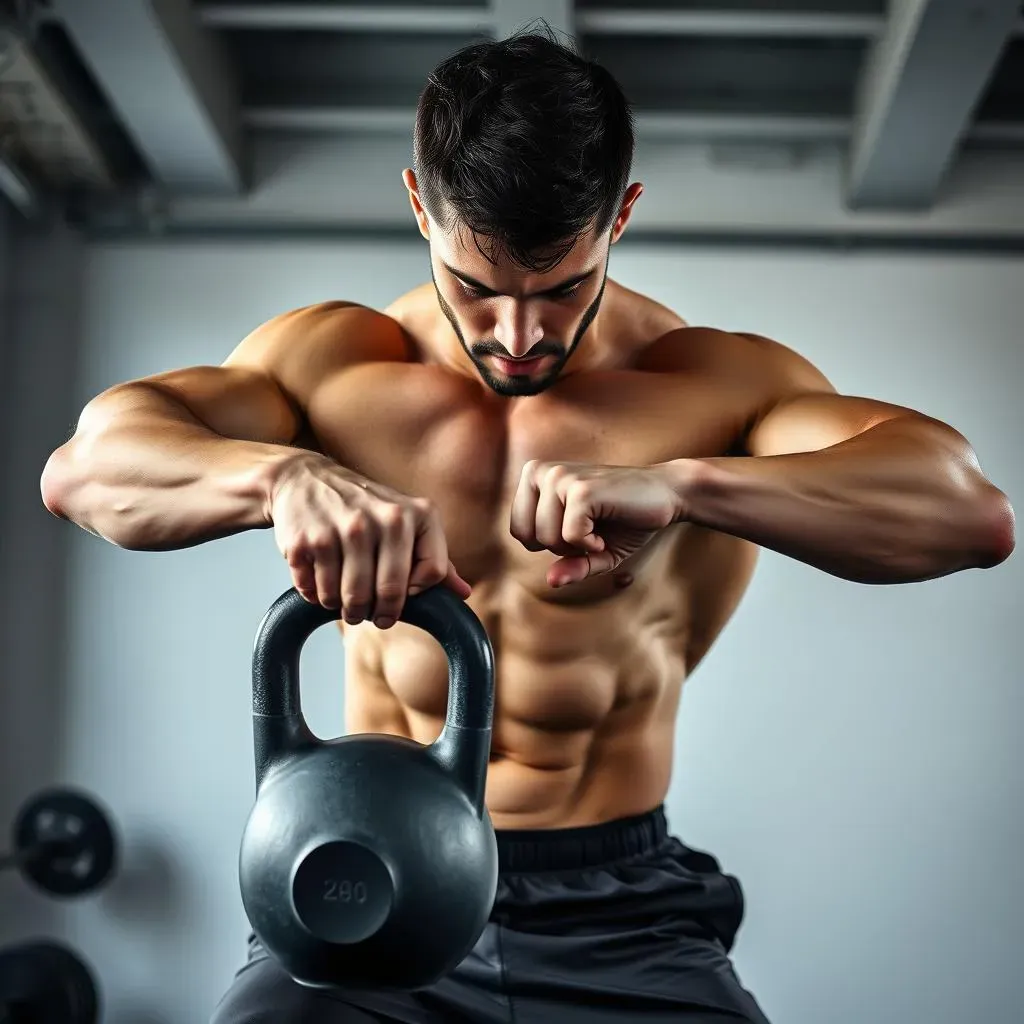Table of Contents
Ready to transform your fitness routine with a single, powerful tool? This article dives deep into the world of kettlebell upper body and core workout, proving that you don't need a room full of equipment to build serious strength and stability. Whether you're a seasoned athlete or just starting your fitness journey, a kettlebell can unlock a new level of full-body conditioning. We'll explore a curated selection of exercises designed to target every major muscle group in your upper body while simultaneously engaging your core for enhanced power and balance. Forget endless crunches and bicep curls; prepare for dynamic movements that mimic real-life actions, building functional strength that translates to everyday activities.
Maximize Your Strength: Kettlebell Exercises for Upper Body and Core

Maximize Your Strength: Kettlebell Exercises for Upper Body and Core
Two-Handed Kettlebell Shoulder Press
Let's kick things off with the Two-Handed Kettlebell Shoulder Press. This isn't just about building bigger shoulders; it's about forging a stronger, more stable upper body. Think of it as the cornerstone of your kettlebell upper body and core workout. By using both hands, you can handle a heavier weight, which translates to increased strength gains. Plus, it forces your core to work overtime to stabilize your body throughout the movement.
The benefits extend beyond raw strength. You'll improve your overhead stability, enhance shoulder mobility, and build a solid foundation for more complex exercises. Whether you're pressing for power or endurance, this exercise is a must-have in your arsenal. I remember when I first started incorporating this into my routine, my shoulder stability improved dramatically, which helped with everything from pull-ups to carrying groceries!
Kettlebell Bent Over Row
Next up, we have the Kettlebell Bent Over Row, a powerhouse exercise for your back and biceps. This move is all about building a strong, resilient back that can handle anything life throws your way. It targets your lats, rhomboids, and traps, creating a well-rounded upper body physique.
What sets the kettlebell version apart is the unique grip and offset weight distribution. This challenges your stabilizer muscles even further, leading to improved grip strength and overall body control. Focus on maintaining a flat back and pulling with your elbows to maximize muscle engagement and minimize the risk of injury. Trust me, your back will thank you for this one. It's a great way to counteract all that time we spend hunched over our desks!
Single Kettlebell Workout: Core and Upper Body Integration

Single Kettlebell Workout: Core and Upper Body Integration
Unilateral Kettlebell Floor Press With Glute Bridge
Let's talk about the Unilateral Kettlebell Floor Press with Glute Bridge. This exercise is a game-changer when it comes to integrating your core and upper body. By combining a floor press with a glute bridge, you're not just working your chest and triceps; you're also activating your glutes, hamstrings, and core stabilizers. It's a fantastic way to build upper body strength while simultaneously improving hip stability and core control.
The unilateral aspect adds another layer of complexity. By pressing the kettlebell with one arm, you force your core to work overtime to prevent rotation and maintain balance. This translates to improved functional strength and better overall body awareness. Plus, the glute bridge component helps to counteract the anterior pelvic tilt that can result from prolonged sitting. It's a win-win situation!
Unilateral Kettlebell Pushup
Now, let's dive into the Unilateral Kettlebell Pushup. This isn't your average pushup; it's a dynamic exercise that challenges your strength, stability, and coordination. By placing one hand on the kettlebell, you create an unstable base of support, forcing your core and stabilizer muscles to work overtime to maintain proper form. This not only builds upper body strength but also enhances your proprioception and body awareness.
The uneven weight distribution demands greater core engagement to prevent your body from twisting or collapsing. This makes it an excellent exercise for developing anti-rotational strength, which is crucial for activities like running, swimming, and even carrying heavy objects. Plus, the increased range of motion can help to improve shoulder mobility and flexibility. It's a challenging but incredibly rewarding exercise that will take your pushup game to the next level. Remember to start slow and focus on maintaining a straight line from head to heels.
Two-Handed Kettlebell Skull Crusher
Time for the Two-Handed Kettlebell Skull Crusher, an exercise that's often overlooked but incredibly effective for targeting your triceps. This move is all about isolating and strengthening the muscles on the back of your arms, leading to improved pressing power and better overall arm definition. By using a kettlebell instead of a barbell or dumbbell, you can achieve a greater range of motion and a more natural movement pattern.
The kettlebell's shape allows you to lower the weight further behind your head, fully stretching your triceps and maximizing muscle activation. Just be sure to maintain control throughout the movement and avoid letting the kettlebell crash down on your forehead. A slight bend in your elbows at the bottom of the movement can help to protect your joints. Trust me, your triceps will feel the burn with this one. It's a great way to add variety to your arm workouts and challenge your muscles in new ways.
Exercise | Muscles Targeted | Benefits |
|---|---|---|
Unilateral Kettlebell Floor Press With Glute Bridge | Chest, Triceps, Glutes, Core | Improved Upper Body Strength, Core Stability, Hip Extension |
Unilateral Kettlebell Pushup | Chest, Shoulders, Triceps, Core | Enhanced Stability, Body Awareness, Anti-Rotational Strength |
Two-Handed Kettlebell Skull Crusher | Triceps | Increased Tricep Strength, Improved Pressing Power, Arm Definition |
Effective Kettlebell Training Techniques for Upper Body Strength

Effective Kettlebell Training Techniques for Upper Body Strength
Prioritize Proper Form
First and foremost, nail your form. With kettlebells, it's not just about lifting heavy; it's about moving well. Especially when you're focusing on effective kettlebell training techniques for upper body strength, you need to ensure every rep counts. Think controlled movements, engaged core, and proper alignment. If your form starts to break down, it's time to lower the weight or take a break. Remember, quality over quantity every single time. I've seen so many people get injured trying to lift too heavy too soon. It's just not worth it.
Focus on mastering the fundamental movements before progressing to more complex exercises. This will not only reduce your risk of injury but also ensure that you're targeting the right muscles and maximizing your results. Consider filming yourself performing the exercises to identify any areas where your form could be improved. Small tweaks can make a big difference in the long run.
Progressive Overload is Key
Next, embrace progressive overload. This means gradually increasing the demands on your muscles over time. It could be adding weight, increasing reps, or decreasing rest periods. The key is to consistently challenge yourself without sacrificing good form. If you're always lifting the same weight for the same number of reps, your progress will eventually stall. Find ways to push yourself a little bit further each workout, whether it's adding a pound or two to the kettlebell or squeezing out an extra rep.
Don't be afraid to experiment with different rep ranges and set structures to find what works best for you. Some days you might focus on heavy, low-rep sets to build strength, while other days you might opt for lighter weight and higher reps to improve endurance. The important thing is to keep your body guessing and prevent it from adapting too quickly. This will ensure continuous progress and prevent plateaus. Remember, consistency is key. Even small, incremental improvements add up over time.
Focus on Mind-Muscle Connection
Last but not least, cultivate the mind-muscle connection. This is all about consciously focusing on the muscles you're trying to work during each exercise. It's not enough to simply go through the motions; you need to actively engage your muscles and feel them contracting and stretching. This will not only improve your muscle activation but also enhance your body awareness and control. Close your eyes for a moment before each set and visualize the movement, focusing on the muscles you want to target. During the exercise, pay attention to how those muscles feel and make sure they're doing the work.
By focusing on the mind-muscle connection, you can make even the simplest exercises more effective. This is especially important when using kettlebells, as the offset weight distribution can make it challenging to isolate specific muscles. Take the time to really feel the muscles working and adjust your form as needed to maximize their engagement. Trust me, it makes a huge difference. Once you establish a strong mind-muscle connection, you'll be able to get more out of every workout and see better results in the long run. For example, when doing the kettlebell row, I really focus on squeezing my shoulder blades together at the top of the movement to maximize back muscle activation.
Technique | Description | Benefits |
|---|---|---|
Proper Form | Focus on controlled movements, engaged core, and proper alignment. | Reduces risk of injury, maximizes muscle engagement, improves exercise effectiveness. |
Progressive Overload | Gradually increase the demands on your muscles over time. | Ensures continuous progress, prevents plateaus, promotes strength and endurance gains. |
Mind-Muscle Connection | Consciously focus on the muscles you're trying to work during each exercise. | Improves muscle activation, enhances body awareness, increases workout effectiveness. |
Building a Strong Core and Upper Body with Kettlebell Workouts

Building a Strong Core and Upper Body with Kettlebell Workouts
The Power of Compound Movements
When it comes to building a strong core and upper body with kettlebell workouts, compound movements are your best friend. These exercises, like the clean and press, snatch, and Turkish get-up, engage multiple muscle groups simultaneously, maximizing your calorie burn and building functional strength. They force your core to work overtime to stabilize your body, leading to improved balance, coordination, and overall athleticism. I'm a huge fan of compound movements because they mimic real-life actions and build strength that translates to everyday activities.
Think about it: when you pick up a heavy box, you're not just using your arms; you're engaging your legs, core, and back. Kettlebell compound movements train your body to work as a cohesive unit, making you stronger and more resilient in all aspects of life. Plus, they're incredibly efficient, allowing you to get a full-body workout in a fraction of the time compared to isolation exercises. For example, the kettlebell swing not only works your glutes and hamstrings but also engages your core and shoulders, making it a fantastic exercise for overall strength and conditioning.
The Importance of Core Engagement
Now, let's talk about core engagement. Your core is the foundation of all your movements, and it plays a crucial role in kettlebell training. A strong core not only improves your stability and balance but also protects your spine and reduces your risk of injury. When performing kettlebell exercises, it's essential to actively engage your core by drawing your navel in towards your spine and bracing your abdominal muscles. This will create a solid base of support and allow you to generate more power.
Think of your core as the engine that drives your movements. Without a strong core, you'll be leaking power and increasing your risk of injury. Focus on maintaining a neutral spine throughout each exercise and avoid arching or rounding your back. This will ensure that your core is properly engaged and that you're protecting your spine. Incorporating exercises like planks, Russian twists, and dead bugs into your routine can also help to strengthen your core and improve your kettlebell performance. I always tell my clients to imagine they're about to get punched in the stomach and brace their core accordingly. It's a simple but effective way to ensure proper engagement.
Exercise | Muscles Targeted | Benefits |
|---|---|---|
Kettlebell Clean and Press | Shoulders, Core, Legs | Full-Body Strength, Power, Coordination |
Kettlebell Turkish Get-Up | Full Body | Stability, Mobility, Core Strength |
Kettlebell Swing | Glutes, Hamstrings, Core, Shoulders | Posterior Chain Strength, Power, Conditioning |
Unlocking Your Potential: The Power of Kettlebell Upper Body and Core Workouts
Integrating a kettlebell upper body and core workout into your fitness regime can be a game-changer. From enhancing functional strength to improving core stability and overall athleticism, the benefits are undeniable. Remember to prioritize proper form, gradually increase the weight, and listen to your body to avoid injuries. With consistency and dedication, you'll not only sculpt a stronger, more defined physique but also unlock a new level of confidence and physical capability. So, pick up that kettlebell and start swinging your way to a fitter, healthier you!